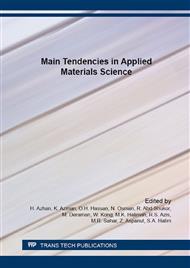p.216
p.225
p.230
p.237
p.245
p.256
p.264
p.274
p.283
Quantum Confinement of Integrated Pulse Electrochemical Etching of Porous Silicon for Metal Semiconductor Metal Photodetector
Abstract:
Porous silicon (PS) was successfully synthesized via novel integrated pulsed electrochemical etching of an n-type (100) silicon (Si) substrate under various condition. The PS was etched using hydrofluoric acid (HF) based solution and the porosity was optimized by introducing electroless chemical etching process prior to photo electrochemical (PEC) anodization. In the electroless etching, a delay time (TD) of 2 min was applied. After that a cycle time (T) and pause time () of pulsed current were supplied throughout the 30 min PEC etching process. As grown Si and PS through conventional direct current (DC) anodization were also included for comparison. The result obtained showed that applying delay time helps to improve the uniformity and density of the porous structures. AFM indicated that the roughness of the Si increases as the dissolution of the Si occurred. Raman spectroscopy showed that an improvement in the crystalline quality of PS under pulse etching method compared to DC method indicated by the reduction of full width at half maximum (FWHM). A broad visible photoluminescence (PL) was observed from green to red with blue shift as nanocrystallite size decreases which constituted quantum confinement effect from the PS structures. Nickel (Ni) finger contact was deposited onto the PS to form metal semiconductor metal (MSM) photodetector. Ni/PS MSM photodetector by pulse method exhibited higher gain (2 times) compared to conventional Si device at 5 V bias.
Info:
Periodical:
Pages:
245-255
Citation:
Online since:
March 2016
Price:
Сopyright:
© 2016 Trans Tech Publications Ltd. All Rights Reserved
Share:
Citation:


